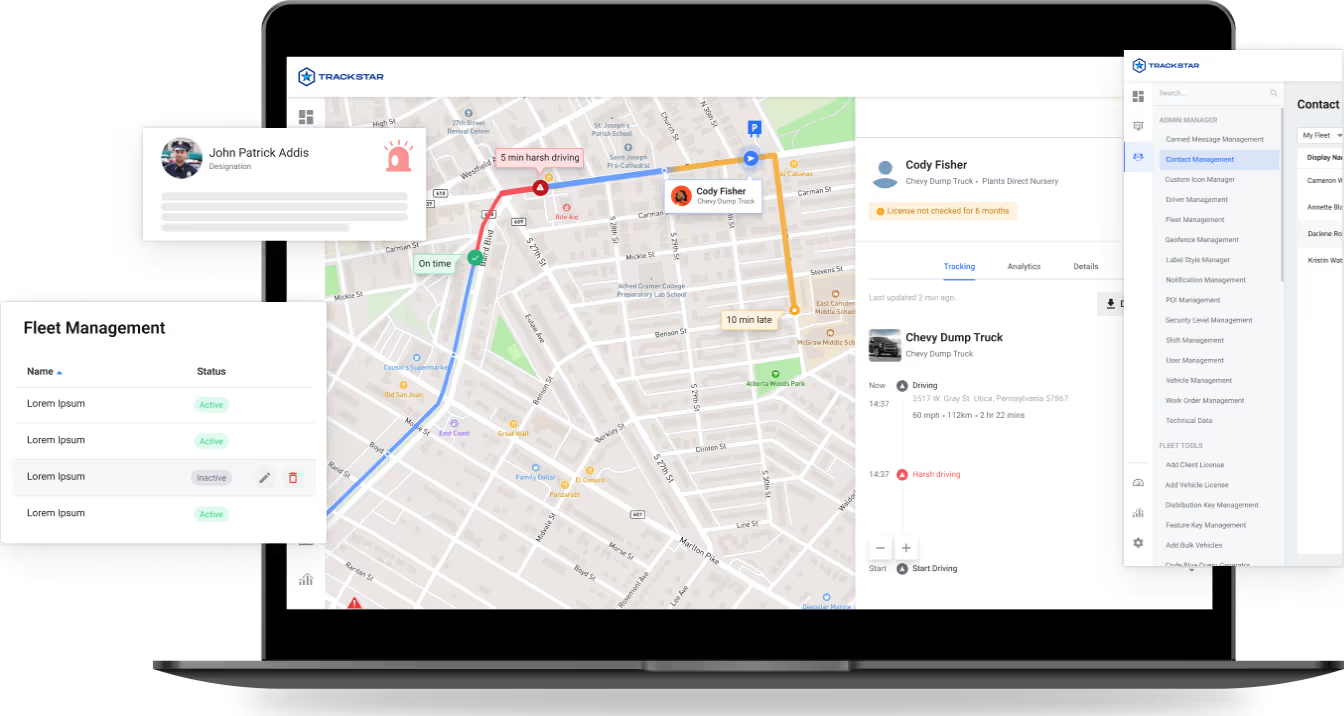Fleet tracking has become a standard for any operation that manages dozens, hundreds, or even thousands of vehicles. But what is fleet tracking supposed to look like in 2025? When it doesn’t give visibility into the trailers, heavy equipment, or assets, you’re carrying more liability than you might realize.
To understand why, we need to look at what fleet tracking really is, what it should include in 2025, and why equipment visibility matters as much as vehicle tracking.
What is fleet tracking?
Fleet tracking is the process of using GPS and telematics to monitor the location, usage, and performance of vehicles. At its core, it tells you where your assets are, who is operating them, and how they’re being used.
But in modern fleet management, the definition has expanded. It’s no longer just about dots on a map. Today’s systems combine GPS with IoT sensors, diagnostics, compliance data, and even video feeds to deliver a real-time picture of your entire operation.
The best systems integrate directly with enterprise asset management (EAM) tools, giving managers a single view of vehicles, assets, financials, and infrastructure. This unified approach transforms fleet tracking into an operational control center that reduces costs, increases uptime, and improves safety.
Why vehicle-only tracking falls short
If your GPS solution only shows asset locations, you’re missing half the story. Equipment that travels with those vehicles (trailers, generators, heavy machinery) carries equal financial and operational weight. Without visibility into those assets, your team is left guessing about their location, usage, and condition.
That lack of clarity often means a stolen or misplaced asset isn’t noticed until it’s long gone, or a critical piece of machinery sits idle when it should be in use. And the problems don’t stop there. Maintenance schedules get overlooked when you can’t see hours of use across all assets, leading to shorter lifespans and costly repairs.
Billing and utilization reports become unreliable, cutting into revenue and leaving customers frustrated. In the event of an accident or dispute, not having verifiable data on equipment use can increase liability and even impact insurance outcomes. In short, every gap in visibility adds risk, and every risk carries a real financial consequence.
Ultimately, fleet tracking without equipment visibility is like running a warehouse without inventory control. Every missing layer of visibility adds risk. True fleet tracking demands GPS integrated with video telematics, equipment monitoring, and enterprise asset management.
The role of fleet dash cams and video telematics
Modern fleet tracking is incomplete without video. Fleet dash cams, paired with GPS and telematics data, provide context that location alone can’t deliver. They capture driving behavior, protect drivers against false claims, and create an evidence trail for insurance and compliance.
Truck camera systems with multiple angles (forward-facing, driver-facing, and side views) extend this protection. They support driver coaching, deter risky behavior, and help reconstruct incidents with precision. When combined with GPS and telematics IoT data, video telematics transforms into a liability shield, ensuring fleets can prove what really happened on the road.
GPS with video telematics: reducing liability and cost
Liability is one of the largest hidden costs in fleet management. According to the Federal Motor Carrier Safety Administration, average large truck crash costs exceed $90,000 per incident, and cases involving injury or litigation can run much higher. A GPS system with integrated video telematics reduces this risk in three ways:
- Accident evidence: Recorded footage accelerates claims and prevents false accusations.
- Driver behavior data: Managers can identify and correct unsafe practices before they cause incidents.
- Theft prevention: Video acts as a deterrent and provides actionable leads when assets are targeted.
Organizations that use GPS with video telematics consistently report lower insurance premiums, reduced accident rates, and faster resolution of disputes. These benefits outweigh the upfront cost of implementation.

Equipment tracking: extending visibility across the operation
The liability doesn’t end with vehicles. Heavy equipment, rental assets, and mobile tools all represent significant investments. When they aren’t tracked, fleets lose revenue opportunities and face higher downtime.
Enterprise-level solutions like Track Star address this by integrating GPS fleet tracking with enterprise asset management (EAM). This approach provides a single dashboard where fleets can see everything: vehicles, equipment, and even fixed assets like substations, bus stops, parking lots, or HVAC systems.
For rental companies, this visibility means knowing exactly when equipment is being used, when it’s overdue, and when it needs maintenance. For utilities and municipalities, it means safer, more accountable operations.
How Track Star helps reduce liability
Track Star delivers a fully unified platform that brings GPS tracking, fleet dash cams, video telematics, and equipment monitoring into one system. Hardware flexibility ensures fleets can use existing devices, while open APIs allow integration with systems like computer-aided dispatch (CAD) for public safety.
By combining fleet tracking with enterprise asset management, Track Star clients gain the visibility needed to cut liability, improve compliance, and drive ROI. The result is not just fewer accidents and claims, but more efficient, transparent operations across vehicles and equipment.
Final thoughts
So, what is fleet tracking without equipment visibility? It’s a liability. Organizations that stop at vehicle-only GPS tracking miss out on crucial data that keeps fleets safe, compliant, and profitable. By extending visibility to equipment, adding fleet dash cams, and adopting GPS with video telematics, managers can protect assets, reduce costs, and operate better.
If your current system doesn’t deliver this level of coverage, it’s time to upgrade. Book a demo with Track Star today and see how full visibility can transform your fleet.

.png)
.png)